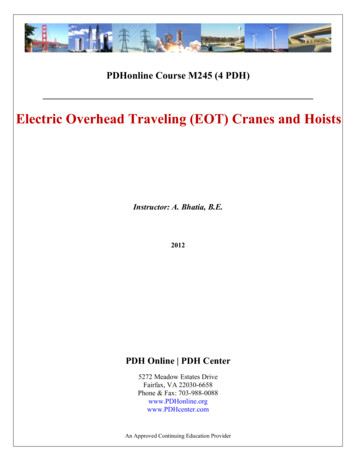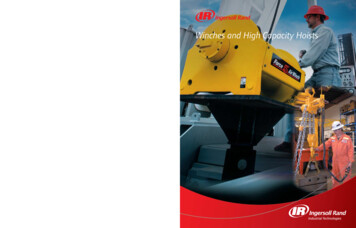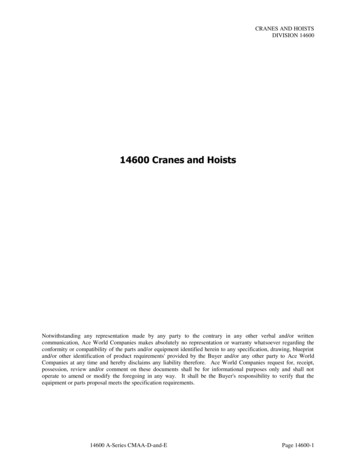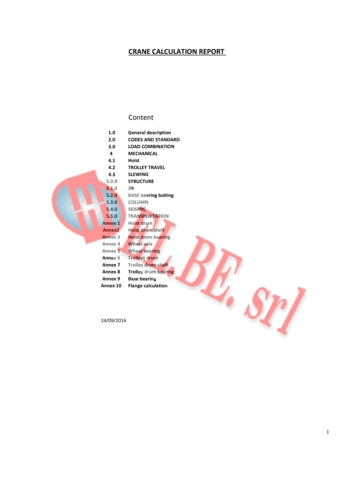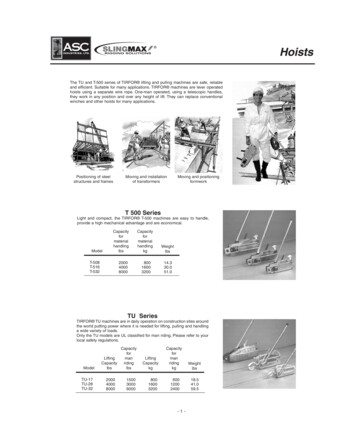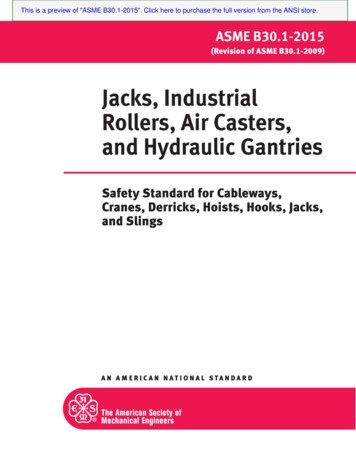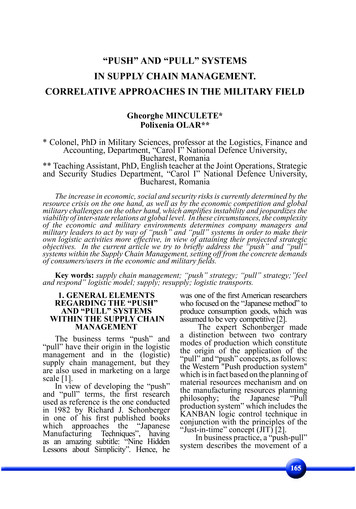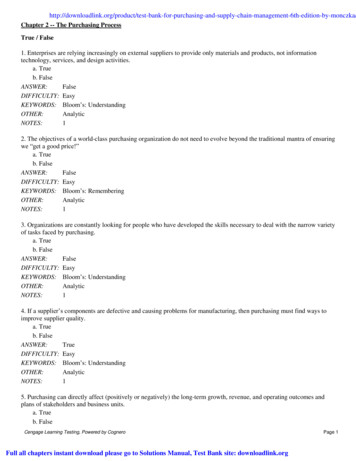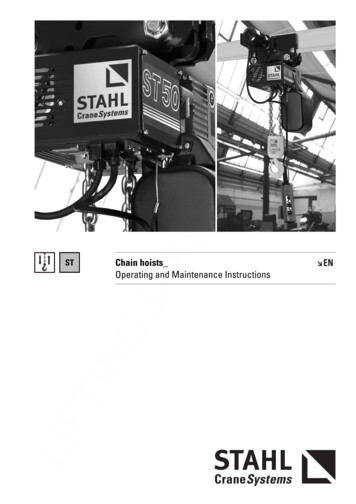
Transcription
STChain hoistsOperating and Maintenance Instructions
Fundamental informationYou have purchased a product manufactured by STAHL CraneSystems GmbH.This chain hoist has been constructed in compliance with the applicable standardsand regulations.Inspect hoist for damage caused in transit immediately upon delivery.Report damage caused in transit and after consulting the manufacturer/supplierrepair or have repaired before installation and commissioning.Do not install or commission a damaged enance and elimination of faultsmay only be carried out by a qualified personTerms employedUserWhoever uses and employs the chain hoist or has it operated by suitable trained personnel is considered to be the user (employer/company).Trained personnelTrained personnel are persons who have been instructed and trained in the dutieswith which they are entrusted and the risks which may arise from incorrectbehaviour, have been advised on the necessary protective devices, precautions,applicable regulations, accident prevention regulations and prevailing conditionsand have proven their ability.Skilled electricianA skilled electrician possesses knowledge and experience on electrical equipmentarising from specialist training and, with knowledge of the applicable standards andregulations, is able to assess the work with which he is entrusted and detect andavoid possible risks.Definition of a qualified person:A qualified person is one with the necessary qualification, based on theoretical andpractical knowledge of hoists, for the required activities as listed in the operatinginstructions.The person must be in a position to assess the safety of the installation inconjunction with the application.Persons with the authority to undertake certain maintenance work on our productsinclude service engineers of manufacturer and trained fitters with the correspondingcertification.BAST 02.FMSeminars:Comprehensive understanding of material handling products is a prerequisite for thecorrect use of equipment. Competent and practically oriented, we impart the specialist knowledge required for the correct use, monitoring and care of your installation.Ask for our seminar programme.209.07
Table of contents1Safety instructions1.11.21.31.41.51.61.71.8Symbols . 4Operating instructions. 4Use for intended purpose . 5Safety-conscious operation. 5Organisational safety precautions. 6Eletrical equipment. 6Warranty. 6Periodic tests. 62 Getting to know the chain hoist. 73 ng stationary chain hoist . 8Installing trolley. 8Installing trolley on chain hoist . 9Connecting electric trolley . 11Runway endstop . 11Fitting the chain box . 11Fitting the control pendant . 12Checking screw connections . 12Mains connection . 12Dismantling . 124 Commissioning4.1Checklist for commissioning . 135 Operating5.15.25.3Duties of crane operator . 14Operating control pendant . 15Emergency stop . 156 6.13Maintenance work . 16Maintenance intervals . 16Hook . 17Load chain. 17Checking function of slipping clutch . 18Adjusting slipping clutch . 18Hoist motor brake . 20Oil change . 20Travel motor brake. 21Oil change . 21General overhaul . 21Trolley. 21Operating hours counter (optional) . 217 Repairs7.1Chain drive . 228 Wearing parts8.18.2Hoist . 24Trolley. 2499.19.29.39.49.59.69.79.8Classification in acc. with FEM . 25Ambient conditions. 25Hoist motor data. 26Travel motor data . 27Specifications for mains connection. 28Lubricants. 30Sound level. 31Chain certificate. 31Technical dataBAST 02.FMSubject to alterations09.073
1 Safety instructions1.1 SymbolsIn these operating instructions, the following symbols indicate particularly importantinformation on risks and safety in operation.Safety at workThis symbol marks all information on safety at work where risks to life and limb areentailed.Warning of electrical voltageCovers such as hoods and caps which are marked with this symbol may only beopened by "qualified persons or suitably instructed personnel".Warning of suspended loadIt is forbidden for persons to stand under suspended loads. This entails risks to lifeand limb!Safety in operationInformation marked with this symbol must be observed to avoid damage to the chainhoist or the goods transported.In these operating instructions, these symbols mark particularly important information on risks and safety in operation.Operating instructionsRead carefully and follow the operating instructionsBAST 02.FM1.2411.05
1 Safety instructions1.3 Use for intended purpose Chain hoists are intended for lifting freely movable and guided loads that cannottilt. Depending on their design, they are for stationary or mobile use. If loads are tobe towed horizontally, or in the case of guided loads, automatic operation,continuous deadweight or constantly repeated hoisting motions, the individualapplication must be assessed. Contact the manufacturer in case of doubt. If the hoist forms "part of a machine," the person placing it on the market mustensure that the hoist meets the specific regulations of the application. Runways, suspensions and endstops must be of suitable dimensions. Do not carry out any alterations or modifications. Additional fitments must beauthorised by the manufacturer. The declaration of conformity may be invalidated. Load chain hoist only up to the permissible safe working load, following the data onthe rating plate. (Caution: danger of load falling)Not permitted are for example:- Exceeding the safe working load- Transporting persons- Pulling loads at an angle- Pulling loads loose, dragging or towing loads- Manipulating the slipping clutch- Operating the hoist with slack chain- Touching the chain during the hoisting motion- Operating a damaged hoist- Operating the hoist with the chain twisted- Approaching the emergency limit switch in normal operation- Operating the chain hoist without a phase monitoring relay if the control pro-videdby the customer is not installed in the terminal box on the chain hoist, but forexample in a stationary control cabinet.1.4 Safety-conscious operationThe ST chain hoists are constructed according to the state of the art and equippedwith a slipping clutch as overload protection. In spite of this, dangers may arise fromincorrect use or use for an unintended purpose. The operator, see page 2, is responsible for ensuring that work is carried out withsafety in mind and avoiding risks. (EC directive 99/92/EC, Decree on Safety at Work) Read the operating instructions before starting to work with the chain hoist. Observe the "Duties of crane operator", see page 14. Before starting work, find out where the EMERGENCY STOP button is (usually inthe control pendant). Do not place your hand between edges which may pinch or cut. See sketch Do not use the emergency limit switch (ultimate limit switch for highest and lowesthook position) as an operational limit switch. Report damage and defects to the chain hoist (abnormal noises, impaired brakingfunction, deformations, .) to the person responsible immediately. Do not use thechain hoist until the faults have been eliminated. Do not remove information plates from the chain hoist. Replace illegible ordamaged plates. Have hoist inspected by the relevant authority before commissioning.1.5 Organisational safety precautions Only direct persons to operate the hoist if they have been trained or instructed inBAST 02.FMits use. Observe the legal minimum age! At regular intervals, check that work is being carried out in a safety-consciousmanner. Observe the intervals specified for periodic tests. File the test reports in the test logbook. Store the operating instructions within easy reach where the chain hoist isoperated.10.065
1 Safety instructions1.6 Electrical equipmentChain hoists, models ST05, ST10, ST20, ST30, ST32, ST50 and ST60, can be suppliedwith various versions of electrical equipment.The chain hoist functions with dangerous electrical voltages. Disconnect the chain hoist before opening covers marked with this symbol. The chain hoist may only be opened by qualified personnel (see page 2) or personnel having been instructed.a) Direct control:The motor of the chain hoist is switched on and off directly, i.e. without the use ofcontactors. Mains voltage and mains current are present in the control pendant. Dueto the limited ampacity of the control pendants, direct control is only available up to1.6 kW motor output at 400 V, 3 ph, 50 Hz. Direct control is not permissible in variouscountries (e.g. Canada, U.S.A.) due to legal stipulations and standards.b) Contactor control:The motor of the chain hoist is switched by means of a contactor-transformer combination.A safety extra-low voltage is present in the control pendant.Contactor control is available for all motor sizes and outputs and is accepted worldwide. The control voltage generated by the transformer is selected corresponding tocustomer requirements and national standards. 48 V or 230 V control voltage is generally used in Europe, 120 V in North America.c) Version without control:STAHL chain hoists are available without control. The switchgear (e.g. contactorsand transfo
Have hoist inspected by the relevant authority before commissioning. 1.5 Organisational safety precautions Only direct persons to operate the hoist if they have been trained or instructed in its use. Observe the legal minimum age! At regular intervals, check that work is being carried out in a safety-conscious manner. Observe the intervals specified for periodic tests. File the .File Size: 1MBPage Count: 31
